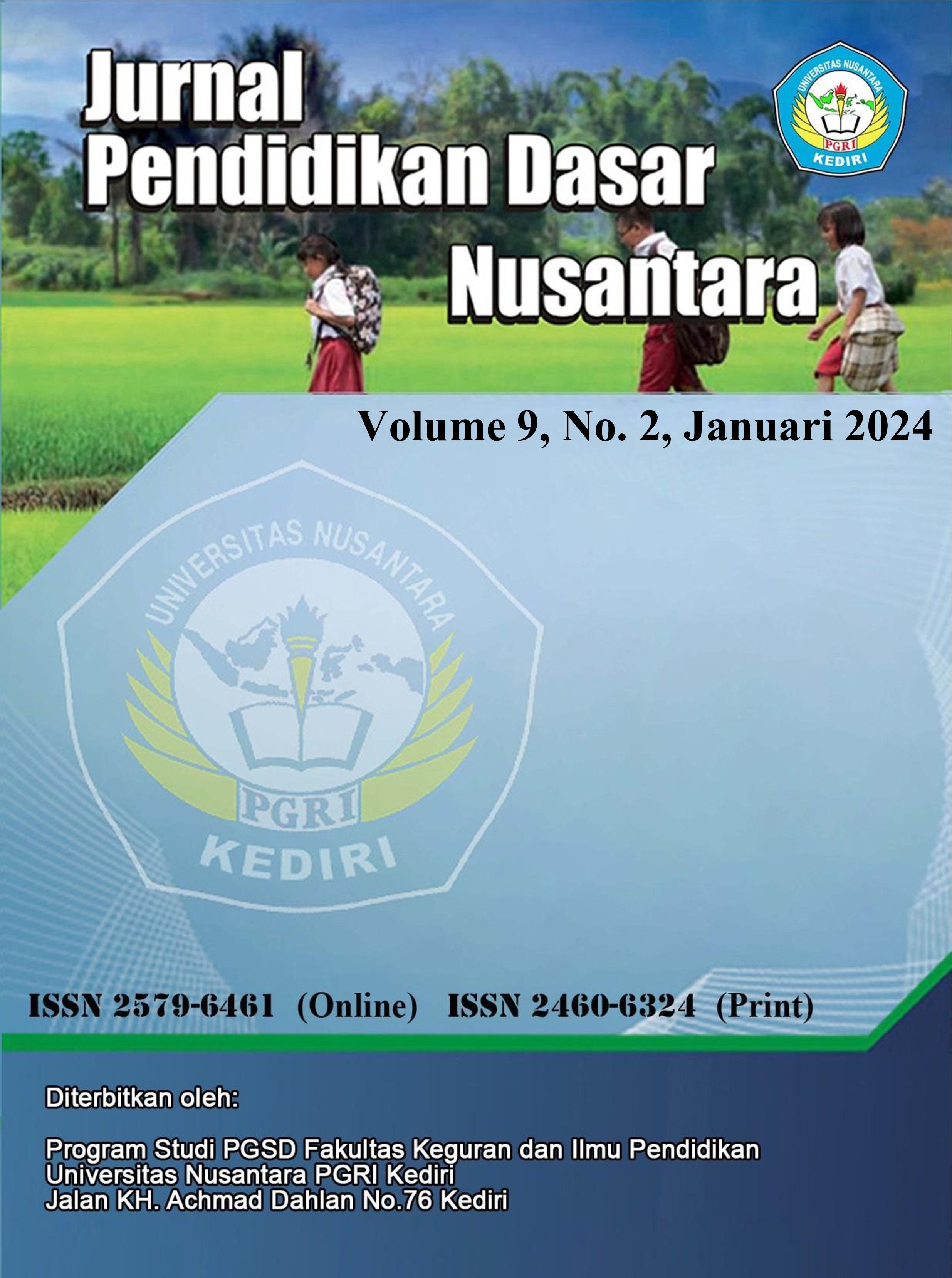Analysis of mastery of material concepts, narrative texts and procedure texts in class 4 MI Hidayatus Shibyan students
DOI:
https://doi.org/10.29407/jpdn.v9i2.22365Keywords:
Analysis, Narrative Text, Procedure TextAbstract
This research aims to analyze the mastery of the concepts of narrative text and procedural text material in grade 4 students at MI Hidayatus Shibyan. This research uses descriptive qualitative methods. Data collection techniques were carried out through test, interview and documentation methods. Based on the results of the research that has been carried out, it can be concluded that class 4 students at MI Hidayatus Shyiban have not mastered the understanding of the concepts of narrative text and procedural text material. The narrative text and procedural text material possessed by students is still low. Factors involving student learning difficulties include teachers often using the lecture method, lack of learning innovation provided by teachers, decreased student enthusiasm for learning, and students' lack of mastery of the material. Therefore, there is a need for a solution in dealing with difficulties in mastering narrative text and procedural text material, namely; reading texts repeatedly in order to understand the material, increasing enthusiasm and interest in learning through the use of learning media and learning models, carrying out concrete learning in understanding procedural texts and procedural texts that can provide experience as well as understanding for students.
Downloads
References
Alam, H. W. N. (2017). Peningkatan Kemampuan Memproduksi Teks Prosedur Kompleks Dengan Menggunakan Metode Demonstrasi. Diksatrasia : Jurnal Ilmiah Pendidikan Bahasa & Sastra Indonesia, 1(1), 32. https://doi.org/10.25157/diksatrasia.v1i1.176
Aldona, D., Ariesta, R., & Utomo, P. (2022). Kemampuan Menulis Teks Prosedur Siswa Kelas VIII SMP Negeri 2 Rejang Lebong. Jurnal Ilmiah Korpus, 6(3), 424–430.
Ali, M. (2020). Pembelajaran Bahasa Indonesia Dan Sastra (Basastra) Di Sekolah Dasar. PERNIK : Jurnal Pendidikan Anak Usia Dini, 3(1), 35–44. https://doi.org/10.31851/pernik.v3i2.4839
Alimah, M., & Indihadi, D. (2022). Analisis Teks Narasi Implementasi Strategi Mind Mapping Peserta Didik di Sekolah Dasar. Edukatif : Jurnal Ilmu Pendidikan, 4(4), 5512–5519.
Alvidril, A., & Ratna, E. (2021). Struktur, Isi, Dan Unsur Kebahasaan Teks Prosedurkarya Siswa Kelas XI MIPA SMA Negeri 5 Padang. Pendidikan Bahasa Dan Sastra Indonesia, 10, 34–44.
Dakhliah, S. (2019). Kemampuan Menulis Teks Prosedur Siswa Kelas VIII SMP Negeri 10 Parepare. Jurnal Pendidikan BUM, 3(1), 2499–2508.
Desti Ayunisyah, S., Arifin, M., & Yulistio, D. (2020). Analisis Struktur Teks Prosedur Siswa Kelas VII SMPN 7 Kota Bengkulu. Jurnal Ilmiah Korpus, 4(1), 118–127. https://doi.org/10.33369/jik.v4i1.8346
Fatmawati, M, N. H. Y., & Andriani. (2020). Analisis Kemampuan Memahami Isi Teks Narasi Siswa Kelas VII SMP Negeri 4 Tapalang Barat. Journal Peqguruang: Conference Series, 2 (September).
Guci, K. U., & Hafrison, M. (2020). Kontribusi Pemahaman Teks Prosedur Terhadap Keterampilan Menulis Teks Prosedur Siswa Kelas VII SMP Negeri 10 Padang. Pendidikan Bahasa Indonesia, 8(3), 201-214.
Hieronimus. (2017). Meningkatkan Kemampuan Menulis Karangan Narasi Melelui Pendekatan Kontekstual Dengan Inspirator Lingkungan Sekolah Siswa Kelas VII SMP Negeri 1 Sano Nggoang, Manggarai Barat Tahun Pelajaran 2016/2017. Jurnal Ilmiah Mandala Education, 4(1), 9–15.
Khairunnisa, F. (2020). Problematika Pembelajaran Menulis Teks Narasi Di Sekolah Menengah Pertama. Seminar Bahasa Dan Sastra Indonesia, 2(1), 145–151. http://www.conference.unsri.ac.id/index.php/sembadra/article/view/1600
Nirmala, S. D. (2022). Problematika Rendahnya Kemampuan Literasi Siswa Di Sekolah Dasar. Primary: Jurnal Pendidikan Guru Sekolah Dasar, 11(2), 393. https://doi.org/10.33578/jpfkip.v11i2.8851
Nur’aini, D. M. R., Sarwiji Suwandi, & Rohmadi, M. (2023). Pembelajaran Keterampilan Menulis Teks Prosedur Di Sekolah Menengah Pertama. Seminar Nasional PBI FKIP UNS 2023, 16–25.
Oktavia, N., Tanzimah, T., & Suryani, I. (2022). Analisis Pemahaman Konsep Mata Pelajaran Bahasa Indonesia Tentang Teks Narasi Siswa Kelas V SD. Edumaspul: Jurnal Pendidikan, 6(1), 203–211. https://doi.org/10.33487/edumaspul.v6i1.2599
Pitaloka, S., Ramadhanti, D., (2023). Kemampuan Memahami Teks Prosedur Siswa Kelas VII Pesantren Thawalib Padang. ALINEA: Jurnal Bahasa, 3(2), 472–480. https://www.ejournal.baleliterasi.org/index.php/alinea/article/view/536%0Ahttps://www.ejournal.baleliterasi.org/index.php/alinea/article/download/536/369
Rahayu, S. (2016). Meningkatkan Penguasaan Siswa Terhadap Materi Pembelajaran Matematika Dan Bahasa Indonesia Melalui Penggunaan Alat Perga. Jurnal Ilmu Pendidikan Sosial, Sains, Dan Humaniora, 2(3), 189–194.
Ratnasari, I., Sumarwati, & Sarwiji Suwandi. (2016). Peningkatan Kemampuan Menulis Narasi Dengan Teknik Parafrase Wacana Dialog: Penelitian Tindakan Kelas Pada Siswa Sekolah Dasar. Basastra: Jurnal Penelitian Bahasa, Sastra Indonesia Dan Pengajarannya, 4(1), 77–98.
Sabilla, S., Khairani, L. P., & Syaputra, E. (2022). Menganalisis Kemampuan Gemar Membaca Teks Narasi Siswa Di MAN 2 Deli Serdang. Jurnal Multidisiplin Dehasen, 1(3), 159–164.
Sapawi. (2017). Analisis Kesalahan Berbahasa Dalam Karangan Narasi Siswa Kelas VI Sekolah Dasar. Stilistika, 3(2), 75–86.
Sugiyono. (2019). Metode Penelitian Kuantitatif, Kualitatif, R&D (Kedua). In Alfabeta (Vol. 3, Issue 2).
Sugiyono. (2021). Metode Penelitian Pendidikan (Kuantitatif, Kualitatif, Kombinasi, R&D dan Penelitian Tindakan). In Metode Penelitian Pendidikan.
Susanti, D., Priyadi, A. T., & Salem, L. (n.d.). Meningkatkan Kemampuan Menulis Teks Prosedur Melalui Strategi Writing in the Here and Now. Jurnal Pendidikan & Pembelajaran, 1–8. https://jurnal.untan.ac.id/index.php/jpdpb/article/view/34988
Zamariah, M. (2016). Upaya Meningkatkan Pemahaman Konsepbahasa Indonesia Dengan Penerapan Program Remedial Tutor Sebaya Pada Siswa Kelas VI SDN 2 Metro Barat Tahun Pelajaran 2009/2010. 1(1)
Downloads
Published
Issue
Section
License
Copyright (c) 2024 Firda Oktavia Firanti Firda (Author)

This work is licensed under a Creative Commons Attribution-ShareAlike 4.0 International License.
Authors who publish with this journal agree to the following terms:
- Copyright on any article is retained by the author(s).
- The author grants the journal, the right of first publication with the work simultaneously licensed under a Creative Commons Attribution License that allows others to share the work with an acknowledgment of the work’s authorship and initial publication in this journal.
- Authors are able to enter into separate, additional contractual arrangements for the non-exclusive distribution of the journal’s published version of the work (e.g., post it to an institutional repository or publish it in a book), with an acknowledgment of its initial publication in this journal.
- Authors are permitted and encouraged to post their work online (e.g., in institutional repositories or on their website) prior to and during the submission process, as it can lead to productive exchanges, as well as earlier and greater citation of published work.
- The article and any associated published material is distributed under the Creative Commons Attribution-ShareAlike 4.0 International License
































